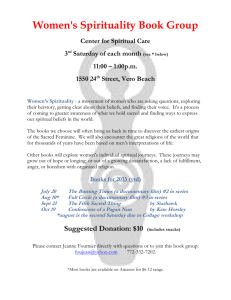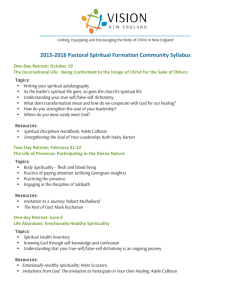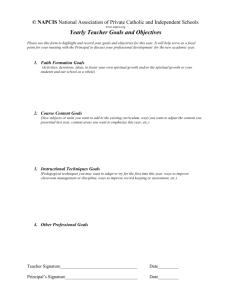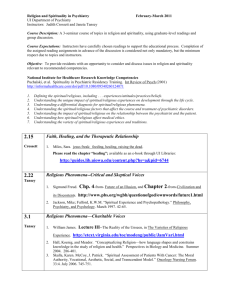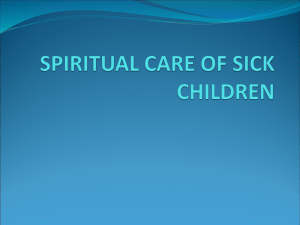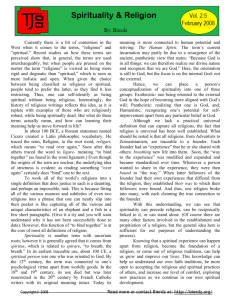File - Claudette D. Johnson
advertisement
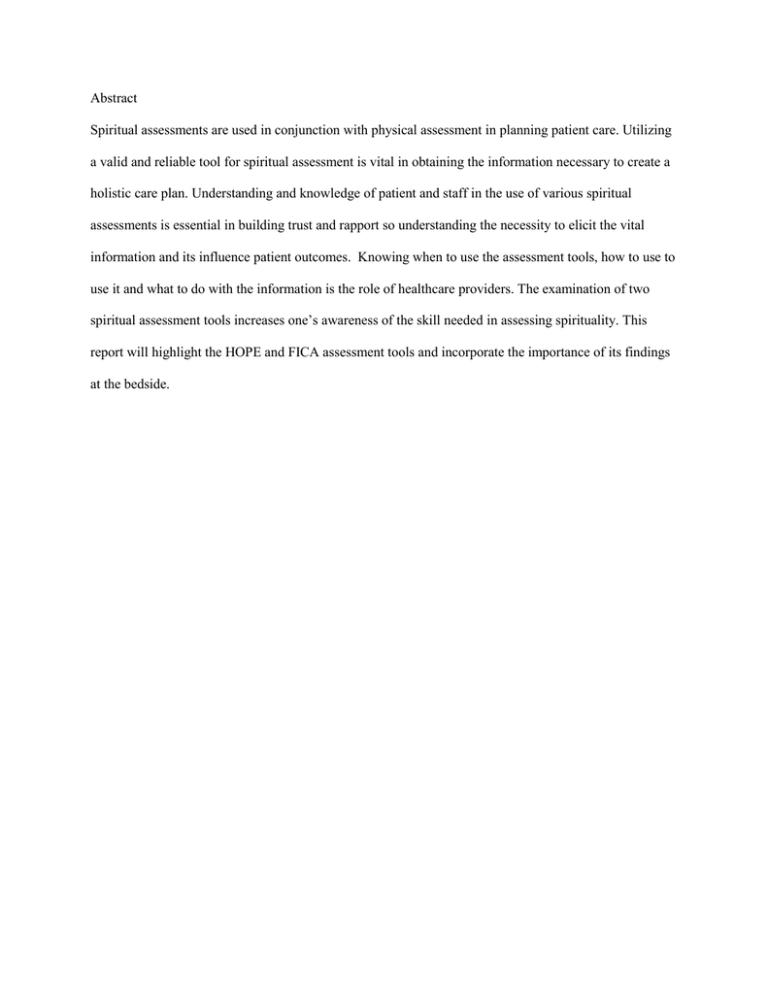
Abstract Spiritual assessments are used in conjunction with physical assessment in planning patient care. Utilizing a valid and reliable tool for spiritual assessment is vital in obtaining the information necessary to create a holistic care plan. Understanding and knowledge of patient and staff in the use of various spiritual assessments is essential in building trust and rapport so understanding the necessity to elicit the vital information and its influence patient outcomes. Knowing when to use the assessment tools, how to use to use it and what to do with the information is the role of healthcare providers. The examination of two spiritual assessment tools increases one’s awareness of the skill needed in assessing spirituality. This report will highlight the HOPE and FICA assessment tools and incorporate the importance of its findings at the bedside. Spiritual Assessment Tool Healthcare’s goal is to provide quality care for patient’s physical, emotional and spiritual needs. Spirituality is complex and reflective of the individual’s internal resources which affect one’s ability to view health. This perspective influences a patient’s recovery (Puchalski, 2001). According to Anandarajah & Hight (2001), spirituality is more than religious and non-religious perspective. Some may find spirituality through music, art, nature (Puchalski, 2001). Identification of patient’s spiritual needs through spiritual assessment is vital for optimal recovery. The Joint Commission on Accreditation (JACHO) revised its standards in 2001, mandating initial spiritual assessments as a requirement for all patients in hospitals, long-term care facilities, home care and mental health settings that treat addiction (JACHO, 2005). The Joint Commission (2005) does not dictate a specific tool but suggest its content include identification of spirituality’s importance as it may affect care. This mandate is influential in integrating spiritual assessment in patient care. A recent study by Monod, Brennan, Rochat, Martin, Rochat, & Büla (2011) revealed that 78% of advanced cancer patients relied on religion to help them cope with their illness, prolonged treatments and end of life decisions. In addition, an overwhelming 77 % of patients believe physicians should consider their spiritual needs. Yet, only 10-20 % reports that caregivers actually discuss spirituality or religion with them (Medical University of South Carolina, 2011). This paper will present two spiritual assessment tools. It will provide an analysis of the tools’ validity and reliability. In addition, the paper will provide an explanation on spiritual assessment’s purpose, its influence and its impact on health care and patient outcomes. Spiritual Assessment Tool Description Spiritual assessment can help identify spiritual needs of individuals. It can gain insight into an individual spirituality and evaluate how an individual’s spiritual practice can affect the way the patient is cared for. The assessment should be conducted as a form of conversation allowing key things to emerge and address on an on-going basis (Laudet, Morgen & White, 2006). The HOPE Assessment Tool Spiritual assessment tool is instrumental in incorporating an individual’s spirituality into healthcare practices. Spiritual assessments can be measured in many ways. One of the tools used in assessing patient’s spiritual belief is the HOPE questionnaire. HOPE concepts are as follows: H stands for sources of an individual’s hope, comfort, meaning, strength, love or connection and finding peace; O- role of organized religion in one’s life; P- for personal spirituality and practices; E- effects of spirituality on medical care including end of life issues (Anandarajah & Hight, 2001). According to Anandarajah & Hight (2001), HOPE assessment is conducted as part of a conversation by first establishing an empathetic connection with a patient with statements such as it must be difficult for you to be sick. It includes the questions to include the following: How are you holding up? Follow –up questions would follow the patient’s lead to include sample questions such as would there be anything you would hope for even if you were not going to get better or are there resources you draw strength from? Positive response to the H question, questioning should proceed to the O with the following: Do you consider yourself religious or how important is this to you and how does it help you? P questions can include Do you believe in God, have spiritual beliefs and practices? E questions will follow positive responses to the first three questions and will assess what the above may have on medical and end of life decisions. Utilizing statements such as Are you worried about how your beliefs conflicts with your medical situation or is there anyone with whom to need to say sorry or express your feelings to? Following this guideline can reveal the way an individual perceives treatment. According to Anandarajah & Hight (2001), HOPE is an instrument utilizing a series of questions to assess the role of spirituality in a person’s life for the main purpose of minimizing spiritual distress. The process involves asking four open-ended questions inquiring about a one’s source of hope, strength, peace and comfort; what particular religion are they involved in; what personal spiritual belief and practices including if that relation is with God; and how the one’s spiritual belief affect their medical care. Lastly, through the responses, spiritual interventions appropriate to address issues will be formulated to maintain religious belief, practices and cultural preferences (Walsh, 2010). Validity and Reliability The HOPE Assessment Tool was developed at the Department of Family Medicine at Brown University by Gowri Anandarajah and Ellen Hight. The advantages of the HOPE tool are that it is brief yet encompasses all the critical areas to be assessed, allowing the caregiver information in a non-threatening way. The HOPE tool is efficient, recognized, easy to remember and proven effective (Walsh, 2010). Its questions were developed as a teaching tool to incorporate spiritual assessments in medical interview for medical students and residents. Validated by research, HOPE questions’ strength is its approach of using open-ended questions to explore an individual’s spiritual resources and concerns (Medical University of South Carolina, 2011). It provides an opportunity for the patient to tell his/her story and allows open discussion of support system and what is important to the patient (unlike physical exam which reveals what is important to the caregiver). Because it does not focus on the word spirituality or religion, it minimizes discussion barriers based on language (Anandarajah & Hight, 2001). Use of this tool in many medical programs adds to the validity and reliability of its purpose (Yates, Chalmer, St James, Follansbee, & McKegney, 1981). FICA Assessment Tool Created by Dr. Cristina Puchalski in 1996 (in collaboration with Drs. Sumalsky, Teno & Matthews), the FICA Spiritual History Tool provides an efficient integration of spirituality to a standard medical assessment. According to Puchalski (1996), the questionnaires were created to reflect what healthcare would need to know about a patient’s spiritual belief in the clinical setting (Puchalski, 1996). Its basis are: F- the presence of faith, meaning or belief; I- importance of spirituality on an individual’s life and the belief/value system on the patient’s ability to make health care decisions; C-spiritual community; and A- addressing needs with interventions. FICA Tool is conducted by first determining faith (F) with questions such as Do you consider yourself spiritual (attitude and beliefs related to God, forces of life or nature) or religious (beliefs, values, rituals) or Do you have beliefs that help you cope or give life meaning? Importance and Influence (I) questions can include what importance does faith have in your life, have your beliefs influence how you handle stress, what role does your belief play in healthcare decisions? (Borneman, Ferrell, Puchalski, 2010). Meanwhile community (C) questions can include are you part of a spiritual or religious community, who can you rely on and how do they support you? The questioning ends with addressing information shared in the patient’s plan of care. Questions by asking how can health caregiver’s best support one’s spirituality and what information can be shared (Puchalski, 1996). FICA tool utilizes open ended questions, allowing for descriptive data. FICA respondents rated faith or spirituality as important or very important in helping patients to cope and control stress. It further revealed the importance of support from family and friends (Borneman, Ferrell, Puchalski, 2010). FICA tool identifies aspects of life that provides the greatest spiritual support. FICA’s framework suggests that inquiry of beliefs opens the door to further conversation about other issues the patient’s may be experiencing (Puchalski, 1996). FICA can draw spiritual belief information on decisions related to health care. The tool help elicit important clinical information such as ability to cope which may affect patient outcomes. Validity and Reliability Evaluations of the FICA tool reveal that the spiritual information gathered helps create clinical plans but many felt its assessment went beyond just healthcare system and extends to the community (Borneman et al., 2010). Interest in spirituality is seen as an aspect of respectful patient care during illness, enhancing patient-caregiver relationship rather than just impacting the plan (Monod, et al., 2011). Findings lend support to the importance of spiritual care as an aspect of quality patient care and use of the FICA tool as a valuable instrument for clinical assessment (Büssing, Balzat & Heusser, 2010). Responses to the FICA questions reveal the depth and breadth of spirituality. The tool opens door for more conversation. Studies support importance of care and tool valuable instrument for clinical assessment (Borneman et al., 2010). Responses to the FICA reveal depth and breadth of spirituality including identification of intervention. The FICA tool is the simplest tool for quick assimilation. Studies suggest the tool is feasible in clinical assessment and enhances patient outcomes seen in many setting: mental health (Walsh, 2010), oncology (Cohen, Mount, Strobel, & Bui, 1995), palliative care as well as crisis intervention (Yates et al., 1981). The tool has been published in many publications and referenced by many studies with positive results for obtaining spiritual information for clinical intervention (Highfield, 2000). How the Spiritual Assessment Would Be Used in a Health Assessment Research indicates a close connection between spiritual needs and physical needs, thus, integrating spiritual assessment into patient care has become an integral part of holistic care (Medical University of South Carolina, 2011). In order to assess spirituality, it is important for the clinician to have some self-awareness of their own spirituality, care for their own spiritual needs, establish good patient relationships and know the appropriate time to discuss the topic (Highfield, 2000). Though spiritual assessments have no clear answers or solutions, its impact has been proven to clearly affect the way a patient faces suffering and illness (Highfield, 2000). Following an assessment, the best therapeutic intervention is presence, acceptance, compassion and understanding (Walsh, 2010). According to spirituality studies by Puchalski (2001), many patients believe spirituality plays an important role in one’s life. Studies also suggest a correlation between patient’s spirituality and health outcomes (Cohen et al., 1995). Patients agree that healthcare providers should consider their spirituality into health care practice influencing pain control and outlook on disease (Yates et al., 1981). Spirituality assessment can be utilized with health assessments to create a treatment plan that considers the patient’s holistic needs. It can be incorporated into preventative care by helping identify and mobilize one’s own internal resources such as using prayer, meditation, yoga, walks or music to bring strength and meaning to events happening around the patient (Walsh, 2010). The inclusion of spirituality as an adjuvant care is an advantage of these assessments. In addition to standard medical treatments, spiritual based measures can affect how one deals with clinical situations (Yates et al., 1981). The patient can turn to music before surgery for relaxation or say a prayer before taking medication to deal with fears. Understanding an individual’s spiritual needs allows for the ability to modify treatment or decisions (Walsh, 2010) such as decisions on stopping or continuing treatments or chemotherapy, referrals of distressed individual to a chaplain or religious minister of the right religion, using relaxation for patients in pain (Highfield, 2000). Conclusion More than 80 percent of Americans perceive religion as important. Issues of belief can affect the health care encounter (Borneman et al., 2010). Spiritual assessment tools such as the FICA, the HOPE questions can be used as a compliment to health care interventions. Spiritual assessments, as the first step, show convincing evidence in its beneficial role in the practice of medicine. If spiritual assessments are done in a compassionate, culturally sensitive way, it can provide relief to our distressed patients and accomplish the healthcare goal of holistic care for those we care for. References Anandarajah, G. & Hight, E. (2001). Spirituality and Medical Practice: Using the HOPE Questions as a Practical Tool for Spiritual Assessment. American Family Physician. 63(1). 81-89. Retrieved from http://www.aafp.org/afp/2001/0101/p81.html Borne man, T., Ferrell, B. & Puchalski, C.M. (2010). Evaluation of the FICA Tool for spiritual assessment. Pain Symptom Management. 40(2):163-73. doi: 10.1016/j.jpainsymman.2009.12.019. Retrieved from http://www.ncbi.nlm.nih.gov/pubmed/20619602# Bussing, A., Balzat, H. & Heusser, P. (2010). Spiritual needs of patients with chronic pain diseases and cancer-validation of the spiritual needs questionnaire. European Journal of Medicine Residency. 15(6). 266-273. PMCID: PMC3351996. doi: 10.1186/2047-783X15-6-266. Retrieved from http://www.ncbi.nlm.nih.gov/pmc/articles/PMC3351996/. Cohen, S.R., Mount, B.M., Strobel, M.G., Bui, F. (1995). The McGill Quality of Life Questionnaire: a measure of quality of life appropriate for people with advanced disease. Palliative Medicine. 9. 207–219. Retrieved from http://www.ncbi.nlm.nih.gov/pubmed/7582177 Highfield, M.E. (2000). Providing spiritual care to patients with cancer. Clinical Journal of Oncology Nursing, 4. 115-120. PMID: 11235248. Retrieved from http://www.ncbi.nlm.nih.gov/pubmed?term=Providing%20spiritual%20care%20to%20pa tients%20with%20cancer%20by%20highfield JACHO (2005). Joint Commission on Accreditation of Healthcare Organizations: Evaluating your spiritual assessment process. Retrieved from: http://www.professionalchaplains.org/uploadedFiles/pdf/JCAHO-evaluating-yourspiritual-assessment-process.pdf Laudet, A., Morgen, K. & White, W. (2006). The role of social supports, spirituality, religiousness, life meaning and affiliation with 12-Step fellowships in quality of life satisfaction among individuals in recovery from alcohol and drug problems. Alcohol Treat Quality Manuscript. 24(1-2): 33–73. doi: 10.1300/J020v24n01_04 Medical University of South Carolina. (2011). Spirituality and Cultural diversity. MUSC Department of Family Practice. Retrieved from http://academicdepartments.musc.edu/family_medicine/Spirituality_and_Health/spirituali tyculturaldiversity.htm Puchalski, C. (2001, October). The role of spirituality in health care. Baylor University Healthcare Center Journal. 14(4). 352-357. PMC1305900. Retrieved from http://www.ncbi.nlm.nih.gov/pmc/articles/PMC1305900/ Stéfanie Monod, Mark Brennan, Etienne Rochat, Estelle Martin, Stéphane Rochat, Christophe J. Büla.(2011, July). Instruments Measuring Spirituality in Clinical Research: A Systematic Review. Journal of General Internal Medicine. 26(11): 1345–1357. doi: 10.1007/s11606011-1769-7 Walsh, F. (2010, September). Spiritual diversity: multi-faith perspectives in family therapy. Family Process. 19(3). 330-348. doi: 10.1111/j.1545-5300.2010.01326.x. Yates, J. W., Chalmer, B. J., St James, P., Follansbee, M., McKegney, F. P. (1981). Religion in patients with advanced cancer. Medical Pediatric Oncology. 9. 121–128. Retrieved from http://www.ncbi.nlm.nih.gov/pubmed/7231358


